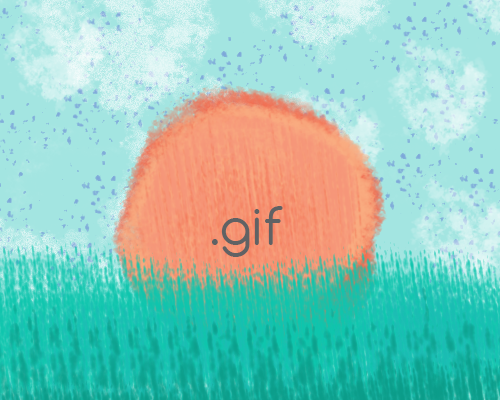It’s the dawn of the publishing GIF. If you pay enough attention, you’ll be able to feel it in the air: the buzzing, looping electricity that knows no bounds. It uses ebooks and the internet to infiltrate our homes and our minds, and once there, it stays and lays low, playing over and over and over again until it’s time. And, my friends, it is almost time.
Anyone else feeling this? No? Well, I guess it’s just me, but I’m here to make the case that GIFs are up and coming in the publishing world—and even to go so far as to say that they’ll eventually end up replacing illustrations in digital publications. Everything is coming together to make this possible: the technology for creating enhanced ebooks, the integration of animation in institutions offering illustration degrees, a growing interest in artists’ use of the GIF as an art form, and a growing interest in GIF illustrations among readers—book consumers like them, and when have we ever let down our readership (especially when they’re offering us money)?
Let’s start with enhanced ebooks, or interactive ebooks. These have a wide range of capabilities: they support audio files, video, animated GIFs, highlighting, note-taking, built-in dictionaries, and touchscreen actions that allow tablet users to interact with stories in a way that wasn’t previously possible. They can do all these things, but I’m just talking GIFs in this blog post. GIFs are the lowest common denominator and relatively cheap to develop; if you want a chance at competing with the other ultra-flashy ebooks, an animated GIF is the cheapest and easiest way to do it. If you’re interested in a longer discussion of enhanced ebooks and their capabilities (with a few examples thrown in), UX Magazine has a great article that outlines everything.
So that’s the story from the technical side of things, but what about the artistic side? More and more, schools are incorporating some sort of animation course into their illustration programs. Just read a few of the descriptions in Animation Career Review’s list of the top forty illustration programs in the US, and you’ll be able to see how the lines between static and animated art have blurred. In fact, some illustration programs are specifically incorporating animated GIFs into their curricula.
There are illustrators outside of the publishing world already using GIFs to tell small, simple stories—much like a static illustration, but with the sensibilities and nuance that movement can provide. They publish their work online, but why not collaborate with a publisher and publish it in an ebook? Here’s a short, incomplete list of some of my favorite artists to give you an idea of what I’m talking about: Daniel Barreto, Nancy Liang, harifa, Max Litvinov, and Qieer Wang.
Additionally, there are already some GIF-illustrated ebooks out and about. One of my recent favorites is The Bright Side by Maren Uthaug, an ebook from Denmark that was acquired and published as a printed graphic novel, but whose aesthetic inspired an interesting journey on the part of the publisher. I also discovered one while writing this post, but all I was able to find were the illustrations without the text. They’re for a book called Zły by Leopold Tyrmand, and they’re part of a graduate project by illustrator Karol Banach. Here’s hoping the complete ebook is out there somewhere, or at least soon will be. And of course there’s always Nathan Pyle’s NYC Basic Tips and Etiquette (basically a classic GIF ebook by now).
And finally, why are we doing this? Because readers love it. Whether it’s because of that turn-of-the-century bliss we get when surrounded by flashy, blinky, gaudy stimuli, or because we’re needing more and more sensory input to actually feel something, anything—whatever it is, SnapApp has put my dramatic stream of consciousness into numbers, if you’re into that sort of thing. If not, just know that people like reading interactive ebooks—they really do.
With all of this in mind, all I have to say is, Can you feel the buzzing in the air?

